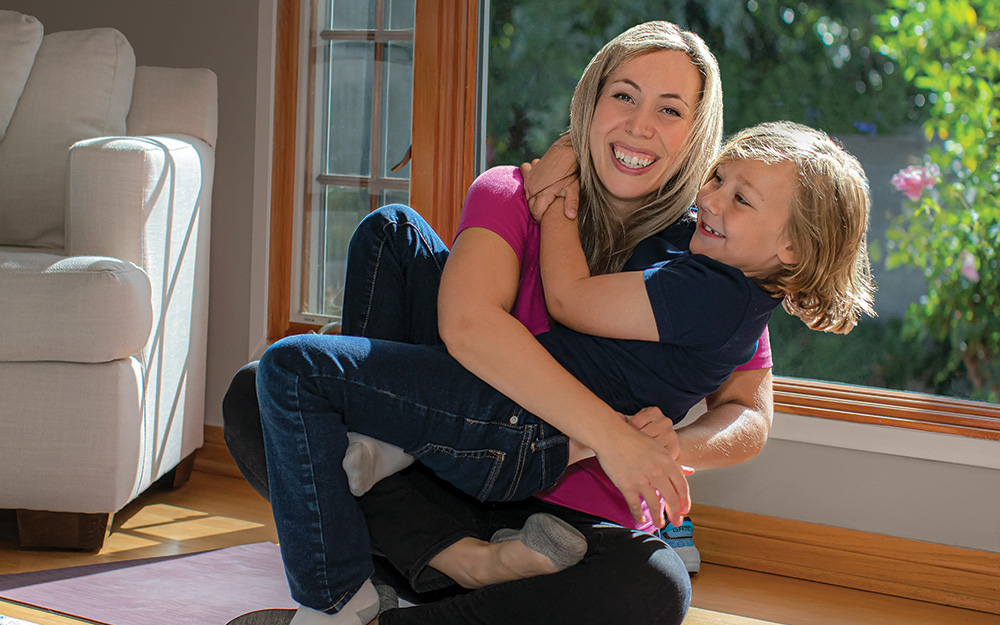Cedars-Sinai Magazine
Right There with You
Jul 06, 2022 Nicole Levine

Every breast cancer surgery is a little different, depending on the needs of the patient. For Lauren DeStefano, MD, there’s one moment that’s always the same.
Just before she begins each surgery, while she waits with her patient for the anesthesia to take effect, DeStefano holds their hands and says, "I'm right here with you." It’s something she learned early in her surgical residency, and it’s stuck with her.
"This is a privilege," says DeStefano, a breast surgical oncologist at Cedars-Sinai Cancer's Tarzana location. "I have to remember that every single time."
DeStefano knows firsthand what it means to face a cancer diagnosis. Her grandmother, who is now in her 90s, and her mother are both breast cancer survivors. DeStefano recalls the intensity of her mother's experience.
"I remember how hush-hush everything was around it, because I was still very young," says DeStefano, who was a teenager when her mom was going through treatment. "When you don't know what’s happening, your mind goes to extremes."
Now she talks to her patients about how to share information in age-appropriate ways with their kids.
"My experiences have definitely affected the kind of doctor I am," she says. "When I'm operating, it might be just another Thursday to me. But for the family in the waiting room, it's one of the scariest days of their lives. Having gone through what I have, I have a great deal of compassion for them."
DeStefano finished her training at Cedars-Sinai during the pandemic. When her program ended, she moved to Seattle for work, but when a job opened at Cedars-Sinai's full-service cancer center in Tarzana in early 2022, she promptly moved back to Southern California.
DeStefano joins fellow breast surgical oncologist Nimmi Kapoor, MD, in the San Fernando Valley office where patients can access an array of services—from primary care to imaging, radiation oncology and radiology. She says that she was drawn to oncology by the multidisciplinary nature of cancer care.
I get to see them when their treatment is done, and they're thrilled to be back to traveling and doing all the things they love. Like I said, it really is a privilege to take care of people."
-Lauren DeStefano, MD
"Our patients truly have a team of doctors behind them, each specializing in one aspect of the patient's care," DeStefano says. "The great thing about Cedars-Sinai cancer care in Tarzana is that all these physicians are in the same building. Not only are our patients able to have experts on their team, but they are all under the same roof.
Something else DeStefano appreciates about working with breast cancer patients is that there are multiple options for treatment, medically and surgically.
"Trying to figure out what treatment option is best is like a puzzle," she says. "In many cases, the surgeries are equivalent in terms of outcomes. So, I ask people, 'What do you want? How do you want your body to look?' We figure it out together."
DeStefano often coaches her patients not to lose sight of the things they love, even when they’re focused on their treatment.
In Discoveries: Scientists Aim To Predict Breast Cancer Risk
"I tell my patients: 'Keep doing the things that make you happy. It’s important for your care," she says. "So, if you enjoy gardening, keep gardening. If you like going for walks, keep doing that."
For DeStefano, movement is the balm she needs when she's struggling. She started dancing when she was just 2 years old. She performed in the New Jersey Ballet's junior company and, as a young adult, thought dance might become her career. Though dance is no longer her professional passion, exercise and movement help her through hard times.
"When I'm stressed and I need to make a decision, moving my body without having to think about anything helps," she says.
Working at an outpatient center, DeStefano mostly treats patients who have early-stage breast cancer that is curable with surgery and treatment. One of her favorite moments with each patient comes during their follow-up appointment, about six months after she gently held their hands in surgery.
"I get to see them when their treatment is done, and they're thrilled to be back to traveling and doing all the things they love," she says. "Like I said, it really is a privilege to take care of people."
BRING IT BACK TO THE BREATH
Meditation is a practice that's helped DeStefano through some of her toughest times—and it works at any age. Even her 7-year-old son, Aidan, is a meditation maven.
Establish a nightly habit: Bedtime is a favorite meditation time for DeStefano and Aidan. She started meditating because she couldn't sleep. Now it's a nightly ritual. Finding a way to quiet your mind can lead to a better night's rest.
Find a digital guide: A variety of guided meditations are available for free through apps. Finding a soothing voice can help start the habit.
Start small: Meditation can begin with even a short practice of a minute or two, then build up to longer stretches of time.
Give yourself time: If you find you can't clear your mind the first time you try, it’s OK. You can't run a marathon the first time you lace up your sneakers, DeStefano says. Bring your attention to your breath and try again.



